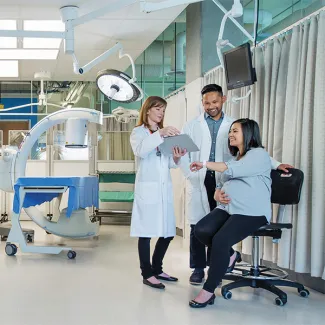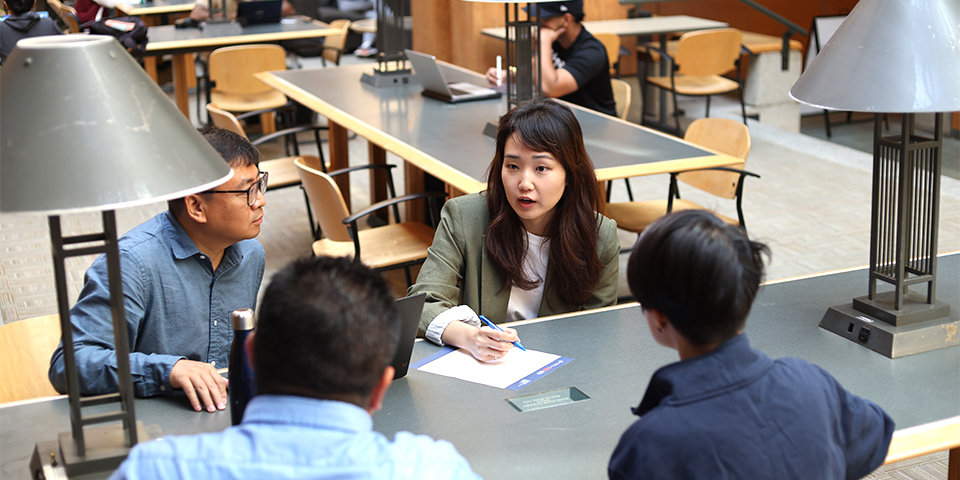From ER nurse to clinical educator: Emily Tang's journey in the MHLP
Just over halfway through the part-time 24-month Clinical Education program, Emily Tang is pursuing her passion for innovation to find ways to support meaningful change in learning and working environments.

Emily Tang has worked in many different practice areas, including as an emergency (ER) nurse (which she loved), in critical care (“which made me realize I prefer the chaos of ER to a more controlled environment”) and in outpatient clinics. She’s also shared her expertise while working as an instructor for licensed practical nurses and as faculty for the Emergency Specialty Nursing Program at the British Columbia Institute of Technology (BCIT).
“As an educator, I found it rewarding to see the proverbial light bulb turn on for so many learners, and the collaborative learning that takes place for both me and for students” she says.
She had long considered investing in a master’s degree but was not convinced that a master’s degree in nursing was aligned with her ambitions. The Master of Health Leadership and Policy (MHLP) stood out for its unique interdisciplinary approach.
“The reason I chose the MHLP over other master’s programs was because it combines health-care leadership and policy, foundational business concepts and clinical education,” she says. “
At the end of the day, health care and advanced education are businesses operating with finite resources, so understanding that intersection while providing high-quality healthcare and education are vital for sustainable systems.”
Part-time student, full-time learning
A few months before she started the part-time 24-month MHLP in January 2024, Emily found out that she’d been offered a position as specialized faculty with the BCIT School of Health Sciences (SoHS) Simulation Program, which is a known leader in the field of integrating simulation into the learning environment. Recognizing that the job was an exceptional opportunity, she embraced being busy and put her time management and prioritization skills to use as she juggled a new full-time job with part-time studies – all while also training for a full marathon in the spring.
Students who do the part-time MHLP program tend to take the bulk of the business and leadership courses in year one. For Emily, that meant taking a series of courses covering topics in organizational leadership, project management and sustainable innovation to solve complex problems.
In the fall term, Emily was accepted into the competitive Creative Destruction Lab (CDL) course. This is a business accelerator program for early-stage companies advancing technologies in advanced therapies, biomedical engineering, cancer treatment, computers, climate and minerals. As part of the course, MHLP students, Master of Engineering Leadership (MEL) students, and Master of Business Administration students are paired with start-up companies where they conduct business analyses and provide advice on a range of topics. The course culminates with students developing a pitch for a group of venture capitalists for why “their” company should receive $50,000 in funding.
“After thoughtful debate and deliberation, it came down to my group and another group being tied with votes from the venture capitalists,” she says.
“The vote was then broadened out to the people in the audience, including student peers, and there was even more discussion. In the end, our company secured the funding, which was so exciting. The work this company is doing is incredible and I cannot wait to see what they do in the future.”
She goes on to say that “while understanding the technical aspects and the business analyses were important, I learned the value of telling a compelling story. The executive director and course instructor of CDL-Vancouver, Darrell Kopke, was exceptional in guiding us through this experience. I gained so much from the CDL course. It gave me a deeper appreciation for how venture capital functions, how to assess the business landscape, and how to craft a strong go-to-market strategy. It was a hands-on, high-energy experience that connected strategy, innovation and storytelling in ways I hadn’t experienced before.”
Emily also took an elective on negotiations that brought together a similarly diverse group of students. “It is very powerful to learn from people who have very different professional and life experiences,” she says. “I am always curious to learn about how different industry sectors approach issues that we also face in health care and education. It’s interesting to explore how solutions in one field can inspire new ways of thinking in another, especially when tackling complex problems.”
Where her first year of the part-time MHLP focused on business courses, in her second year, she’ll focus on health-care courses, including curriculum development, theoretical foundations of clinical education and the politics of health policy.
“I’m only one term into my second year, and the MHLP program continues to scaffold on the learnings I’ve done to date,” she says. “The program has been incredibly relevant to my current work and is helping me strengthen a range of transferrable skills that I know will continue to support my growth in the evolving landscape of healthcare and education.”
She also likes the experiential aspects of the program, noting that in the curriculum development course, for example, students had the opportunity to pitch their ideas to health-care leaders who came to campus to watch and critique their presentations. Similar to the CDL course, this experience with three MHLP-alumni panelists and health-care leaders provided real-time feedback on points of consideration during the curriculum development process.
Emily says she’s been able to apply what she is learning on campus to her career from day one, whether that’s in being more intentional about building relationships, strategies for leadership, instructional design and delivery, knowledge of project management principles, or the tensions of business development and strategic decision-making.
What’s next
Emily has another eight months of the MHLP, which will include a practicum in the fall. She continues to apply what she’s learning in real time across her roles at BCIT, whether in education, simulation or broader project work.
“I’ve grown so much through this program,” she says. “It’s helping me think more critically and strategically, and it’s given me the tools I can use right away. There’s so much happening at the intersection of health care, education and leadership, and I’m excited to keep learning and see where it all leads.”
Emily is especially passionate about innovation and exploring new ways to improve systems and experiences in health and education. “I’m so grateful that the MHLP even exists… that someone had the foresight to combine business, health care and clinical education,” she says. “The professors are incredibly helpful and supportive, and it’s been inspiring to learn alongside so many brilliant, thoughtful peers. I feel lucky to be a part of this program and community.”






